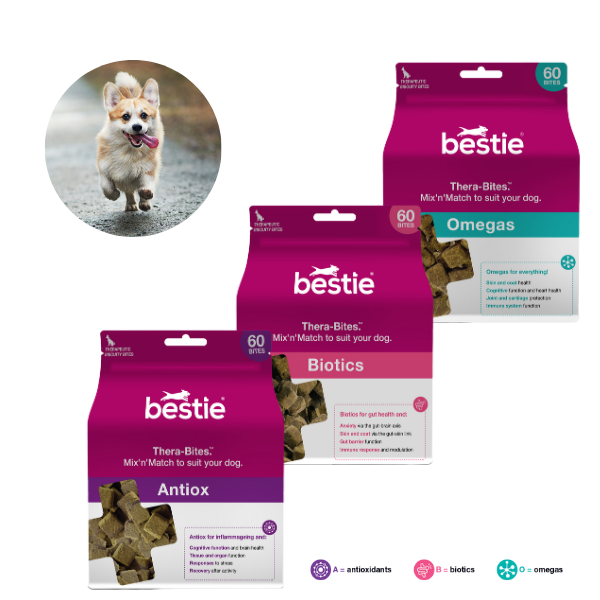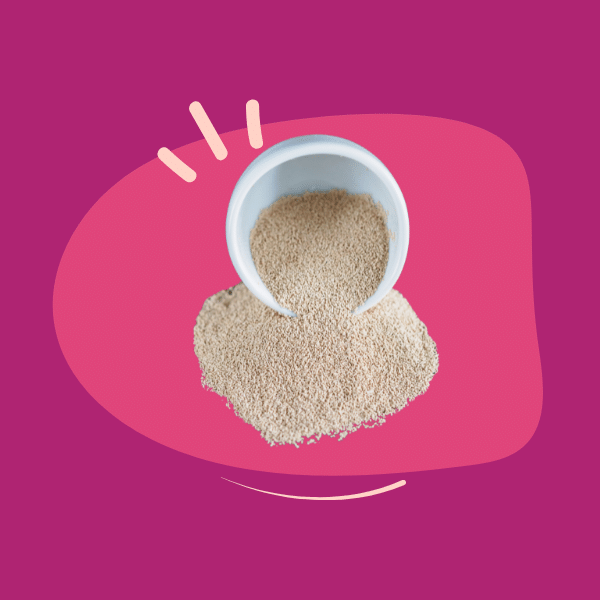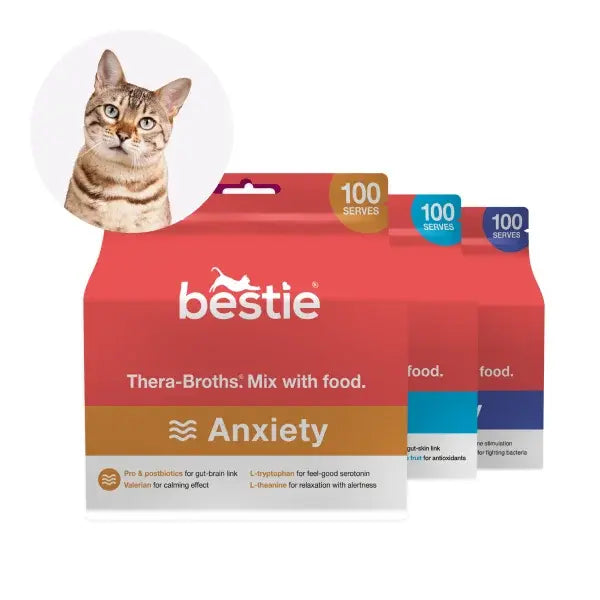In a nutshell:
-
Anxiety and stress in dogs have been linked to genetics, environmental factors and early life experiences. It’s very common.
-
Anxiety typically manifests first as changes in behaviour, however chronic anxiety (stress) can also lead to health problems later on. It can also lead to aggressive behaviour.
-
Environmental enrichment, medication, training and diet supplementation can be used to help dogs feel less anxious.
-
Nutraceuticals combined with training, have been shown to be a great way to reduce anxiety-related behaviours in dogs.
Usually, our dogs aren’t a part of the day-to-day activities we humans find stressful (oh how we wish we could bring them to work!). However, this doesn’t mean that dogs don’t ever feel stressed or anxious.
Specific situations or actions can cause dogs to feel just as stressed as we do sometimes. The problem is that often we just don’t realise what’s going on. Behavioural signs of stress in dogs are commonly misinterpreted as ‘play’ or ‘naughty’ behaviour; sometimes they’re so subtle, we don’t pick up on them.
One study in 2020 found that 72.5% of a sample of 13,700 dogs showed behaviours associated with anxiety.1 This tells us that a lot of dogs feel anxious, and itcauses problems for our dogs in more ways than one.
Anxiety can contribute to health conditions due to anxiety-induced behavioural changes and the stress response at a hormonal level (we’ll talk about that more later). Anxiety can also damage the dog-pet-parent bond. These dogs are often the noisy ones that we avoid at the park or those who can’t be left at home alone. We also know that when anxiety progresses to chronic stress it can contribute to longer-term and more serious health consequences.
Vets can quantify the stress response in animals by measuring the concentrations of hormones such as the known ‘stress hormone’ cortisol. But measuring stress hormones isn’t something we can do at home nor can we ask our dogs how they are feeling. So how can we spot the tell-tale signs of anxiety or stress? And what do we do about it, when we do discover it?
In this article we’ll look at some causes of anxiety in dogs, how to spot anxiety-associated signs and share common remedies for anxiety in dogs.
Why do dogs get anxious?
Some factors associated with anxiety in dogs such as living environment, training, diet and early life can be influenced by pet parents. Interestingly and perhaps frustratingly, breed genetics are also proven to influence anxiety-related behaviour in pets, with some breeds tending to suffer from anxiety more than others.
Let’s go through these factors in more detail, starting from the beginning.
Early life
For those of us who first take home our dogs as puppies, the mass of information we receive about how best to care for them from fellow pet parents, vets and the internet can be overwhelming. It could make us just want to stay at home and play with them all day, protecting them from the scary world and those horrible diseases (parvovirus) we read about in vet’s waiting rooms.
However, we can sometimes do more harm than good by being overly cautious. In the early stages of a dog’s development, socialisation with other dogs and humans helps puppies to learn, explore and challenge the world around them. These activities play a big role in a dog’s behaviour and happiness in later life.
Dogs who have been overly protected early in their lives are far more likely to be nervous and unaware of normal social behaviour, which can lead to conflict with other dogs and humans later on.
Turid Ruggas, a canine behaviourist from Norway, who developed the ‘Stress Escalation Ladder’ which we show a bit later on, says that dogs are social beings who need to learn about communication, polite behaviour and self-control.4
Of course, we need to be aware that puppies are susceptible to diseases. However, this shouldn’t mean we hide them away from their much-needed positive social experiences in their so-called ‘socialisation period’ between 3 to 9 weeks of age.Just think about socialising in special puppy groups or only with dogs vaccinated against infectious diseases. Perhaps avoid those ever-appealing dog parks until they are older. Social enrichment is not only important for puppies but should continue throughout a dog’s life.
You can read more about the stages of a puppy’s early life experiences, development and the hormone ‘cortisol’ we talked about earlier, in our article ‘Setting Puppies Up for Success: The Link Between Stress and Behavioural Problems in dogs.
Living environment
Throughout their life, a dog’s environment can also be something that contributes to anxiety. For example, 'separation anxiety' is a phrase we use to describe dogs that become anxious when left alone. This type of anxiety is thought to be multicausal, we go a little more into detail about it in our article ‘Dealing with anxiety in dogs and cats - an expert perspective’.
For our dogs who have been rescued from animal shelters, separation anxiety is especially common. Their anxious behaviour could even be the initial reason for them being surrendered to rescue.
Other environmental triggers of anxiety can include:
- Absence of a loved one separation anxiety
- Change in family dynamics - social anxiety
- Unexpected events (such as storms) - noise anxiety
- Previous traumatic experiences
- Changes in routine6
The combined effect of the environment and genetics are thought to be responsible for many cases of anxiety.
Breed genetics
Studies have also shown that some breeds are more susceptible to anxiety. If a puppy has been well exposed and socialised and in later life becomes anxious, it’s more likely down to some genetic component.
Studies have shown that ‘behavioural traits’ such as anxiety have ‘small to moderate heritabilities’ which interestingly, the future of dog breeding could even evolve to eliminate.3
There’s also been research into which dog breeds are likely to suffer specific causes or signs of anxious behaviour sometimes:
- Noise sensitivity - Lagotto Romagnolo, Wheaten Terriers, mixed breeds
- Fear generally - Spanish water dogs, Shetland Sheepdogs, mixed breeds
- Fear of surfaces and heights - Rough collies
- Separation anxiety - Wheaten terriers, mixed breeds
- Aggressive behaviour towards strangers - Miniature Schnauzers1
What are the signs of a stressed or anxious dog?
We might bite our fingernails when we’re stressed, but what is the equivalent in dogs? Below are some of the most common manifestations of anxiety:
- Facial expression - dilated pupils, tight lips, flattened ears
- Body stance - tense muscles, cowling, hiding
- Behaviour - being ‘on alert’, lowered tail that can be wagging in a short arc, hyperactivity or stillness, vocalisation, baring teeth/lunging/biting, grooming, destructive activities such as chewing, trying to escape, following pet parents around the house
- Physiological changes - raised hackles, panting, drooling, urination/defecation.2
Not all of the above signs can be easily interpreted, and nor do they mean that our dogs are always anxious. It just emphasises the importance of taking a situation’s context and your pet as a whole into account when trying to understand how they’re feeling.
An excellent way to assess anxiety in dogs is to consider it as a scale, from slight to extreme. This approach also helps us to explain the difference between anxiety and stress.
Turid Ruggas, a canine behaviourist from Norway, developed the ‘Stress Escalation Ladder' (below) which shows the following development of low-level stress (anxiety) to extreme level stress in dogs.

- Low-level stress - displacement behaviours such as sniffing the ground and scratching
- Calming behaviours such as yawning, lip licking, looking or turning away and moving slowly
- Reactions to stress - panting, pupil dilation, sweaty paws, shaking, whale eyes and hackling
- Preparing to take action - the disappearance of calming signals, freezing and closing of the mouth.
- An extreme level of stress causes the dog to prepare to take action - bearing their teeth, growling, possibly withdrawal
- An extreme level of stress forces the dog to act - by biting or lunging.3
Anxiety that progresses to aggression can have a hugely negative impact on the dog-owner bond and be dangerous.
How bad is anxiety bad for dogs in the long term?
During stressful situations, dogs (and we humans) experience physiological changes because of activation of the hypothalamus-pituitary axis and sympathetic adrenal gland. The idea behind these changes is to prepare the body for the fight or flight response related to the hormone cortisol.

This activation causes an organism to adapt in a way designed to help them survive in situations with potential danger. For example, by increasing their heart rate or slowing down their digestive system. (It’s not good to feel like having a snack when it’s time to escape!)
However, these changes are only needed for these emergencies and are not supposed to happen on a regular basis. If anxiety or stress continues over a long time, these physiological changes harm a dog’s health.
It’s known that repeated or long-term stressful situations decrease the efficiency of the immune system meaning that a dog is more susceptible to infection. Stress can also cause inflammation within the body which can contribute to immune-mediated diseases or cancer.
In the longer term, the above can increase the risks of a dog suffering from:
- Gastrointestinal diseases - vomiting weight loss, diarrhoea
- Dermatologic conditions
- Respiratory or heart-related problems
- Decreased lifespan 2
How can we help dogs feel less anxious?
Sometimes, where the cause of anxiety is more obvious, helping an anxious pet to feel better may be more straightforward (such as removing or reducing a stressor). In other cases, triggers of anxiety are best resolved with a multimodal approach.
If possible, pet parents should work alongside their vet and/or professional dog trainer to help their anxious dog feel better.
We’ll go through some methods which could help relieve anxiety in dogs.
Environmental enrichment
Creating a calm space for dogs to rest can help them feel more relaxed and respond well to potentially anxiety-provoking situations in the household. Examples of this include providing them with a constant safe area or even experimenting with sprays or diffusers containing calming pheromones.
Training
Approaching the treatment of anxiety through training can involve several techniques, depending on the cause of the anxiety. For example, techniques such as ‘counterconditioning’ and desensitisation using the help of a professional dog trainer can be beneficial. Exercise can also be incorporated into the training and is known to help reduce anxiety in humans.
Medication
If severe anxiety is caused by a stressful situation known beforehand, (fireworks or a long trip), vets can sometimes prescribe drugs which can help keep the animal calm. Many vets also support the use of natural products such as pheromones or aromatherapy.
Dietary supplementation
Nutraceuticals containing a blend of extracts proven to help reduce anxious behaviour in dogs can be a tasty solution to help combat a pet’s anxiety.
The ‘Om’from Bestie is a therapeutic health chew containing the following ingredients which have been shown to reduce clinical and behavioural symptoms of anxiety in dogs:
L-theanine – an amino acid known for its calming effects which we explain here
Hawthorn - an anti-oxidative superfood
Pomegranate - high in concentrations of allergic acid which has an anti-anxiety effect
Valerian – known for its calming effects which we talk about here
Nutritional yeast - containing B vitamins that help reduce anxiety-associated behaviours.
Tryptophan - known for its calming effects; we go into it more here.
In our article ‘Can nutraceutical supplements have an impact on your dog’s anxious behaviour’ we explain some case studies showing the significant improvement a combination of nutraceutical substances and training can have on anxiety and stress in dogs.
References
- Salonen, M., Sulkama, S., Mikkola, S. et al. Prevalence, comorbidity, and breed differences in canine anxiety in 13,700 Finnish pet dogs. Sci Rep 10, 2962 (2020). https://doi.org/10.1038/s41598-020-59837-z
- Stress and Anxiety - How Do They Impact the Pet? World Small Animal Veterinary Association World Congress Proceedings, 2014 Kersti Seksel, BVSc (Hons), MRCVS, MA (Hons), FACVSc, DACVB, DECAWBM
- ‘The stress escalation ladder’ Turid Rugaas
- ‘The puppy and the young dog about growing up’ Turid Rugaas
- Michelazzi, Manuela & Berteselli, Greta & Minero, Michela & Cavallone, Elena. (2010). Effectiveness of L-theanine and behavioural therapy in the treatment of noise phobias in dogs. Journal of Veterinary Behaviour-clinical Applications and Research - J VET BEHAV-CLIN APPL RES. 5. 34-35. 10.1016/j.jveb.2009.10.020.


















